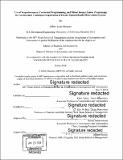| dc.contributor.advisor | Kerri Cahoy and Roy Welsch. | en_US |
| dc.contributor.author | Menezes, Jeffrey Louis | en_US |
| dc.contributor.other | Leaders for Global Operations Program. | en_US |
| dc.date.accessioned | 2018-11-28T15:42:45Z | |
| dc.date.available | 2018-11-28T15:42:45Z | |
| dc.date.copyright | 2018 | en_US |
| dc.date.issued | 2018 | en_US |
| dc.identifier.uri | http://hdl.handle.net/1721.1/119313 | |
| dc.description | Thesis: S.M., Massachusetts Institute of Technology, Department of Aeronautics and Astronautics, In conjunction with the Leaders for Global Operations Program at MIT, 2018. | en_US |
| dc.description | Thesis: M.B.A., Massachusetts Institute of Technology, Sloan School of Management 2018 In conjunction with the Leaders for Global Operations Program at MIT | en_US |
| dc.description | Cataloged from PDF version of thesis. | en_US |
| dc.description | Includes bibliographical references (pages 147-150). | en_US |
| dc.description.abstract | This thesis presents work performed during the course of an internship at An Aerospace Company (AAC) and research performed at Massachusetts Institute of Technology (MIT) Lincoln Laboratory as part of a fellowship. Both efforts entailed the development of architecture tradespace exploration models for space systems. The tradespace exploration model developed at AAC, called the Earth Observation Architecture Isoperformance Model (EO-AIM), uses automation techniques, isoperformance, and constraint programming to rapidly construct potential space-based passive optical EO sensor architecture concepts which meet a given set of customer requirements. Cost estimates are also generated for each sensor concept via integration with stakeholder-trusted cost modeling software allowing for cost to be treated as both an independent variable and consequence when evaluating various architecture solutions. The EO-AIM then uses simple algorithms to identify potential satellite bus options for hosting each sensor architecture in orbit. The total cost of populating an entire constellation based on the sensor architecture is finally estimated using cost estimates for the sensor, satellite bus, and the best launch vehicle option capable of lifting the satellite(s) to orbit. In general, the EO-AIM seeks to bolster's AAC's capabilities for conducting architecture trade space exploration and initial proposal development given advancements in satellite bus, launch vehicle, and sensing technologies. The tradespace exploration model developed at MIT Lincoln Laboratory is a satellite network mixed integer linear program (MILP) which is used for making system architecture decisions and estimating final architecture cost. The satellite network MILP is formulated as both an assignment problem and a network maximum flow problem which must send sensor generated data to a ground user. Results of the MILP vary with the selected objective function and provide insights on the potential benefits of architecture decisions such as sensor disaggregation and the utility of introducing additional communication nodes into existing networks. The satellite network MILP is also capable of verifying network data volume throughput capacity and providing an optimized link schedule for the duration of the simulation. Overall, the satellite network MILP model explores the general problem of optimizing use of limited resources for a given space-based sensor while ensuring mission data needs are met. It is a higher fidelity alternative to the simple satellite bus and launch vehicle compatibility algorithm used in EO-AIM. Both models are shown to improve architecture tradespace exploration of space-based passive-optical EO systems. With a simple demonstration, it is exhibited that using the EO-AIM can increase sensor architecture concepts generated by a factor of ten or more by creating all feasible sensor architecture concepts given user inputs and settings. Furthermore, the use of the satellite network MILP to examine alternative network architecture options for NASA's HyspIRI mission resulted in a system architecture with 20% higher data throughput for marginally less cost. | en_US |
| dc.description.statementofresponsibility | by Jeffrey Louis Menezes. | en_US |
| dc.format.extent | 150 pages | en_US |
| dc.language.iso | eng | en_US |
| dc.publisher | Massachusetts Institute of Technology | en_US |
| dc.rights | MIT theses are protected by copyright. They may be viewed, downloaded, or printed from this source but further reproduction or distribution in any format is prohibited without written permission. | en_US |
| dc.rights.uri | http://dspace.mit.edu/handle/1721.1/7582 | en_US |
| dc.subject | Aeronautics and Astronautics. | en_US |
| dc.subject | Sloan School of Management. | en_US |
| dc.subject | Leaders for Global Operations Program. | en_US |
| dc.title | Use of isoperformance, constraint programming, and mixed integer linear programing for architecture tradespace exploration of passive Optical Earth Observation Systems | en_US |
| dc.type | Thesis | en_US |
| dc.description.degree | S.M. | en_US |
| dc.description.degree | M.B.A. | en_US |
| dc.contributor.department | Leaders for Global Operations Program at MIT | en_US |
| dc.contributor.department | Massachusetts Institute of Technology. Department of Aeronautics and Astronautics | |
| dc.contributor.department | Sloan School of Management | |
| dc.identifier.oclc | 1062443890 | en_US |

